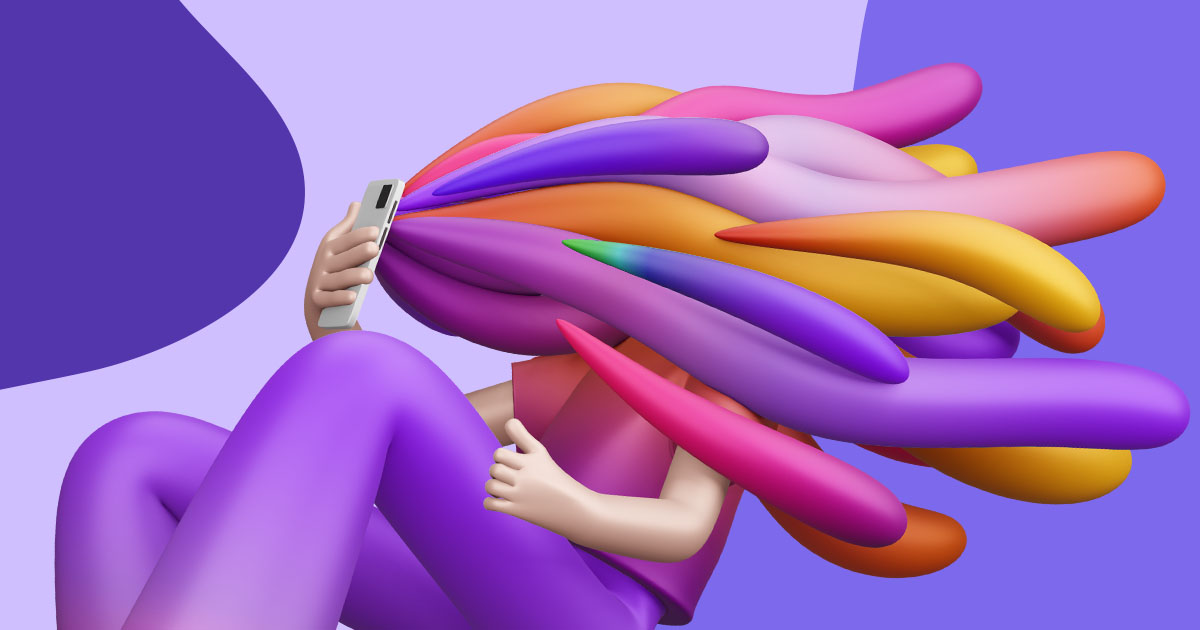
TL;DR: Generative design is the artificial intelligence tool that creates multiple designs based on your needs. It encourages creativity, speeds things up, but the better prompt you give, the better and more humanized results you’ll receive.
AI has taken over our world over the past few years. From art to music to writing, art has explored its farthest reaches. Now, it comes to Generative Design. Powered by artificial intelligence, design does something we never thought it could: revolutionize the creative space. With graphic design AI tools, everything is at your fingertips to explore never-ending possibilities, saving precious time along the way while enhancing creativity and innovation.
What is Generative Design?

Using computer algorithms and AI, generative design is the creative process that is used to create a variety of design solutions. It gets its ideas from the specific requirements and constraints the designers feed it. It then explores the many variables and possibilities to find the best options.
Generative design utilizes technology to help designers come up with innovative and optimized designs that they may not have known of using traditional methods. In short, generative design enhances creativity, saves time, and paves the way for designers to gain more access to design exploration.
Advantages of Generative Design

While it may be unfamiliar territory to many, generative design offers many benefits. You’d be surely missing out if you didn’t explore it right now. Below are some vital advantages that should make you rethink generative design if you’re still in doubt:
Enhanced Creativity
Generative design broadens the scope of creative possibilities by producing a wide range of design options that designers were previously unaware of. It sparks innovation by exploring novel approaches and testing the boundaries of traditional design thinking.
Optimization and Efficiency
Generative design uses algorithms and computing power to optimize designs based on predetermined criteria. This includes performance, cost, or weight, among many others. With it, designers can quickly find the most efficient solutions by automating the design iteration process.
Managing Complex Problems
Generative design is excellent at solving complex design problems with multiple variables and constraints. It is capable of processing and analyzing vast amounts of data to allow designers to tackle challenges that would be time-consuming and impractical to solve manually.
Improved Customization Capabilities
Customizing designs will be simpler and easier with generative design. Designers can input their specific parameters or preferences to generate bespoke designs that precisely match these. This results in producing a more personalized and user-centric design.
Sustainable Designs
When designers incorporate environmental factors and optimization objectives into generative design, they promote sustainability. With it, they can create designs that reduce energy use, minimize material waste, and improve the overall ecological footprint. This will lead to more environmentally friendly and sustainable solutions.
Time and Cost Savings
Generative design saves you time and money by automating design exploration and optimization. Designers can swiftly cycle through various design options, find the best ones without extensive manual labor, and speed up the design process while cutting costs.
In summary, generative design provides designers the power to overcome traditional design limits and open up new avenues. It encourages innovation, improves efficiency, and allows for sustainable design solutions.
Applications of Generative Design

As generative design revolutionizes various industries, its presence is becoming apparent. We can find its applications in the following areas:
Architecture and Urban Planning
Generative design is now disrupting the architecture and urban planning landscape by creating innovative building designs, enhancing structural integrity, and exploring sustainable solutions. It helps architects produce intricate and compelling building geometries while improving energy efficiency and advancing urban planning processes.
Design Types: 3D building models, floor plans, urban layouts, landscape designs.
Product Design and Manufacturing
Generative design is transforming the product design process by creating optimized and lightweight structures. It enables designers to experiment with unique configurations while taking production limitations into account. The result is a product that is both aesthetically pleasing and functionally superior.
Design Types: Product mockups, 3D printable models, packaging designs, industrial components.
Fashion and Textile Design
The fashion world has not been exempted from the beautiful powers of generative design. It is reshaping the industry by automating pattern creation, experimenting with new material combinations, and developing unique designs. It lets designers create customized garments and textiles, which leads to better personalization and creativity in the fashion and textile industry.
Design Types: Textile patterns, fashion illustrations, clothing mockups.
Automotive and Aerospace Industries
Thanks to generative design, the automotive and aerospace industries are seeing the development of lighter and more effective vehicle and aircraft components. It helps optimize structural integrity, enhance aerodynamics, and improve fuel efficiency. This translates to more sustainable transportation solutions.
Design Types: Component parts, concept vehicle renders, aerodynamic simulations.
Game Design and Virtual Reality
Game development and virtual reality experiences are now being enhanced with generative design. It helps with the creation of realistic environments, procedural content generation, and the production of unique characters and assets. It is improving how immersive video games and virtual simulations are.
Design Types: Game characters, virtual landscapes, in-game assets, UI/UX elements.
Medical and Healthcare
Generative design is making its advances in the medical and healthcare fields. It is helping create customized implants, prosthetics, and medical equipment. It also helps in optimizing designs for patient-specific needs which improves comfort, functionality, and overall therapeutic effects.
Design Types: Medical illustrations, custom prosthetic models, data visualizations.
How to Get the Best Results from Generative AI
Getting the best design from an AI tool depends on how clear your instructions are. If your prompt is vague, the result will be basic. Here’s a simple guide to writing better prompts:
- Be Clear and Detailed: Don’t just say “a logo for a coffee shop.” Instead, try: “a simple logo for a modern coffee shop called ‘The Daily Grind,’ with a coffee bean and rising sun design, using warm colors like brown and orange.”
- Describe the Style: Add words like “vintage,” “modern,” “cartoonish,” or “realistic” to explain the look you want.
- Explain the Layout: Tell the AI where things should go. Use phrases like “close-up,” “wide shot,” “centered,” or “off to the side.”
- Set the Mood: Use words like “fun,” “calm,” “professional,” or “playful” to show the feeling you want.
- Keep Improving: If the first design isn’t right, use it to figure out what to change. Update your prompt to get closer to your idea.
Why Human Designers Still Matter: The Penji Advantage
While Graphic design AI tools are powerful, they won’t have the creative element a person can bring. While AI can throw something together in seconds, it won’t get what’s behind your brand and what’s marketing it to its best audience. Penji does just that. We are the best of both worlds.
Not only do we provide you with amazing Graphic design AI services, but we also have human Graphic designers who create what you envision based on your outline. Our designers have access to these tools and bring real-world experience.
You get fast and efficient results without the lost quality only a human designer can provide.
The Challenges of Generative Design

While the possibilities that generative design offers seem limitless, it does have its challenges. One of which is the ethical considerations that surround the automated design processes. There has to be an equal balance between automation and human creativity to avoid raising questions about responsibility, accountability, and the potential loss of the human touch in design.
The Future of Generative Design

Looking ahead, the future of generative design holds immense potential for disrupting many industries. As technology continues to advance, it is expected to be more accessible and user-friendly. It is projected to empower designers and creators, especially as it enters its integration into many more varied fields. In addition, generative design systems and their collaboration with humans will evolve, guiding and refining the design outcomes.
Overall, generative design can reshape many creative processes, foster innovation, and revolutionize industries. We will soon see a future where the design possibilities are limitless.
Ready to Create Something Amazing?
Generative design is here to stay, and it’s one of the fundamentals by which creatives will use going forward. AI will help get us to levels we’ve never reached before, but it only works when humans and machines collaborate with one another.
Graphic designers are eager to have assistance that enhances design capabilities and prevents redundant tasks from bogging us down. Whether you need AI design services or professional graphic design services, it’s all about results at the end of the day.
Let Penji show you what our designers can do for you. Click here to view our plans and get started today!
Frequently Asked Questions (FAQs)
What are the main challenges of generative design?
Generative design’s main challenges are ensuring its outputs are practical and manufacturable, managing complex software, and addressing ethical concerns. Balancing automation with human oversight is key.
How much does generative design software cost?
Costs vary widely. Some tools offer affordable subscriptions, while advanced enterprise-level software may require a significant investment. As the technology grows, it’s becoming more accessible.
Will AI replace graphic designers?
Not at all. AI is a powerful tool that boosts a designer’s creativity by automating tasks and providing inspiration. It can’t replace human strategy and emotional intelligence. The future lies in collaboration, where designers use AI to amplify their skills.
Can generative design be used for branding?
Yes! Generative design can create logos, patterns, and other brand assets. By using brand guidelines like colors and fonts as constraints, AI can produce a range of on-brand options for designers to refine.
About the author

Celeste Zosimo
Celeste is a former traditional animator and now an SEO content writer specializing in graphic design and marketing topics. When she's not writing or ranking her articles, she's being bossed around by her cat and two dogs.
Table of Contents
- What is Generative Design?
- Advantages of Generative Design
- Applications of Generative Design
- How to Get the Best Results from Generative AI
- Why Human Designers Still Matter: The Penji Advantage
- The Challenges of Generative Design
- The Future of Generative Design
- Ready to Create Something Amazing?
- Frequently Asked Questions (FAQs)













